I love Spring – all my favorite plants come up and I can get busy foraging – in between rain storms! – and start things tincturing, drying, infusing, and so on. Below is a great article on Spring plants you can use now.
Edible Plants To Forage In Early Spring
If you are like me, when winter begins to fade, my enthusiasm for early spring harvesting is high.
I cover myself well to avoid the mischief of ticks and insects, grab my basket, put a knife in it and a pair of kitchen scissors. Wearing a pair of gardening gloves off I go, searching for a foraging feast!
First I focus on procuring greens (and edible flowers). Then I march on to collect tubers, and lastly, I try to find items with different flavors to complete the meal.
Violets (Viola Spp.)
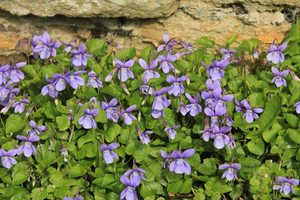 Violet flowers grow from the Mississippi up to the Canadian border in the Northern US.
Violet flowers grow from the Mississippi up to the Canadian border in the Northern US.
The familiar blue or purple violet has serrated, heart-shaped leaves.
They are found along the fringes of the lawn or beneath trees in shady areas.
You may not have to look further for this herb than your backyard – how convenient!
Related: 10 Reasons Why You Need to Make Room for the God of Fungi in Your Backyard
Violets are high in vitamins C, A, and E. You can gather the leaves and the flowers in spring to add to your salad. The leaves can also go into the recipe in this article for Wild Greens stir fry.
Only forage this plant when it is in bloom. Otherwise, you may confuse the greens with other leaves that are not edible.
Sheep Sorrel (Rumex acetoscella)
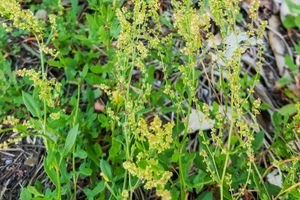 Sheep Sorrel is a lettuce substitute.
Sheep Sorrel is a lettuce substitute.
Located throughout the United States, it has thick, pointed succulent leaves with a tapered tip, fashioned into pointed basal lobes.
You will find it in wastelands, wooded margins, and gardens in the spring.
Chop a cup or so and put it into a salad. Sheep Sorrel is high in oxalic acid so don’t consume more than a cup per day.
Nettle (Urtica Dioica)
Nettles thrive in the sun to part shade.
They prefer damp, wooded areas with rich soil or moist beds near water.
Young, springtime nettle leaves are consumed right from the plant after removing the sticker.
Related: How to Cook Spring Nettles
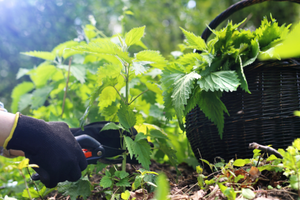
If you gather enough of them, you can add them to a salad like spinach.
Nettles are a superfood containing minerals, calcium, magnesium, potassium, iron, phosphorus, manganese, silica, vitamins C, B vitamins, and chlorophyll.
You must remove the stickers from the leaves and stems before consumption and always wear gloves when harvesting this herb. Please do not consume more than two tablespoons of this herb daily.
Nettles are a strong detoxifying herb. Detoxifying too quickly or without drinking enough water may cause a headache or nausea.
Red Clover (Trifolium Pratense)
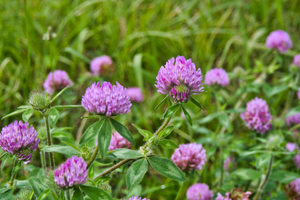 Start gathering Red Clover flowers and leaves in early spring.
Start gathering Red Clover flowers and leaves in early spring.
The plants grow close to the ground, with three leaflets that have a pale green stripe up the center.
The flower head is a rose-purple globe with tiny petals.
You will find it in sunny, open fields and meadows or sunny spots in your lawn or garden.
Incredibly rich in nutrients, Red Clover contains calcium, chromium, magnesium, niacin, phosphorus, potassium, thiamine, and vitamin C.
Purple Dead Nettle (Lamium Purpureum)
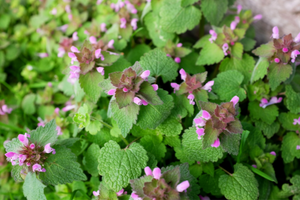 Another variety of nettle that is easy to find in the spring is Purple Dead Nettle.
Another variety of nettle that is easy to find in the spring is Purple Dead Nettle.
It grows in the early to mid spring.
You will find these common clumps of heart-shaped edible leaves, serrated around the edges in part sun to shade fields, meadows and gardens.
In a circular fashion, the light green to purplish leaves the flowers grow, then there is a stem space and then a row of singular pink to purplish tubular flowers.
Use the leaves, flowers or stems in salads, soups, stews, casseroles or egg dishes. Purple Dead Nettle is not quite as strong as other nettle varieties but it is still a good idea to follow the contraindications.
How To Make Wild Greens Stir Fry
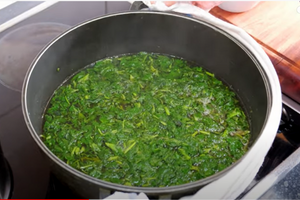 – 1 cups of finely chopped nettle leaves
– 1 cups of finely chopped nettle leaves
– 1 cup of mixed wild greens
– 1 cup of finely chopped green cabbage
– 3 chopped edible mushrooms
– 1 clove of diced wild garlic
– 1 tablespoon of grated ginger root
– 2 tablespoons of sesame oil
-1 tablespoon lemon juice (add ¼ teaspoon of lemon zest if desired)
Sauté the mushrooms first for 15 minutes. Add the garlic, and ginger and cook for five minutes. Add the chopped greens at the end and toss for another five minutes.
Chickweed (Stellaria Media)
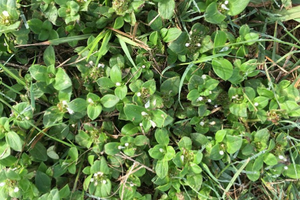 Chickweed can grow in your lawn during the early days of spring.
Chickweed can grow in your lawn during the early days of spring.
It thrives in mild climates yet can grow year-round.
Chickweed has a shallow root system and spreads rapidly. The stem is prostrate with multiple branches.
It is straggly, usually four to six inches long, and its leaves are small, opposite, oval, and flat with hairy petals. Its flowers are very white and small with a deep cleft, plus two parted petals.
You can think of Chickweed as wild lettuce. Parts used include leaves, flowers, and stems. Pick, wash and consume the aerial parts directly like lettuce and add them to sandwiches and salads.
How To Make Chickweed Stew
- Pick your favorite poultry, rabbit, or beef.
- Stew the meat as normal until it is tender.
- One-half hour before the meat is done add four chopped cups of Chickweed, one chopped potato, and two chopped carrots. Mix the ingredients and cover with water.
- Continue to stew for one-half hour. Cool and serve.
Fiddlehead Fern (Atherium Filix-femina)
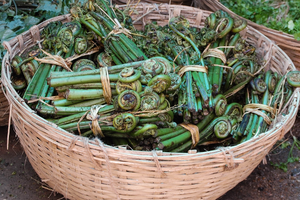 Throughout the temperate Northern hemisphere you’ll find fiddleheads, curled up in damp, shaded forest areas waiting to give you their benefits.
Throughout the temperate Northern hemisphere you’ll find fiddleheads, curled up in damp, shaded forest areas waiting to give you their benefits.
They store nutrients copper, vitamins B3, C and A plus Manganese. They enhance immunity, decrease inflammation, and help build bone strength.
Related: 15 Common Wild Plants You Never Thought Were Edible
Pick the curl before it has matured and the leaves begin to show. Wash them well, the stems and heads are hairy, and sauté them (or eat them raw if you desire a very unique taste.
I recommend finding some Red Clover flowers and adding them to your sautéed fiddleheads. It makes an attractive and healthy combination.
Dandelion (Taraxacum Officinale)
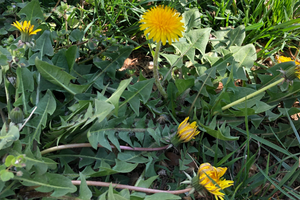 Any northeastern landscape without Dandelion seems unimaginable.
Any northeastern landscape without Dandelion seems unimaginable.
You find it on lawns, between cracks in the driveway, and in rocky areas with poor quality soil.
It is a highly nutritional herb, rich in vitamins A, C, B1, potassium, and minerals.
You can make an entire dinner with this plant! Pick the leaves and eat them fresh after washing, or put them in a salad.
Fry the flowers after you dip them in pancake batter to make a fritter. Last but not least, steep one tablespoon of the fresh roasted root in a quart of water, strain, and drink as a coffee substitute.
Contraindications: This is a diuretic. Take note that it can cause loose stools in the process of detoxification or diarrhea if it is overused.
Wild Asparagus (Asparagus Officianalis)
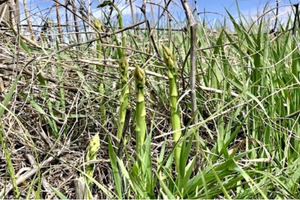 The light green spikes emerge in the early spring along roadsides and fence rows.
The light green spikes emerge in the early spring along roadsides and fence rows.
The easiest time to spot the plant is when the tall feathery adult plants rise up to three feet tall and have small, red berries attached. Parts used however are the spring spikes.
Consume just as you would regular asparagus. I like to chop mine up and put it into a quiche. Another option is to make an asparagus tortilla.
Wild Asparagus Tacos
- Cook the tortilla for less than a minute on either side.
- Add some shredded cheese (optional).
- Take it out of the pan and add some chopped wild greens.
- Lightly poach the asparagus spears until they are soft and an even brighter green.
- Roll them up in the tortilla.
Groundnuts (Apios Americana)
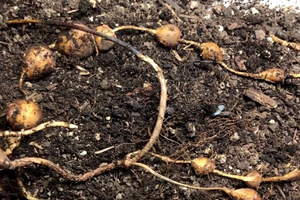 Groundnuts grow throughout the entire US except for southern California and lower Florida.
Groundnuts grow throughout the entire US except for southern California and lower Florida.
They climb, like a pea vine and have multiple tubers along the length of the root.
The leaves are compound, and feather-like.
You will find them on the edges of streams, bogs and thickets. Parts used include the seeds and tubers.
Related: How To Harvest These Seeds For SHTF
The younger tubers that are not so thick skinned taste the best. Cook them in the same way as a lentil bean or a potato. These tubers also make a perfect potato substitute and contain an astonishing 15 percent protein. You can peel and roast them along with your wild garlic.
Do not eat them raw. Raw groundnuts interfere with protein metabolism. Always cook groundnuts.
Jerusalem Artichoke (Helianthus Tuberosus)
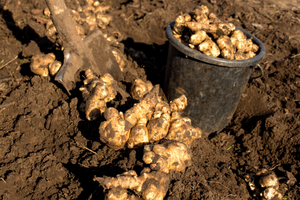 Another tuber you can harvest during the spring is Jerusalem Artichoke.
Another tuber you can harvest during the spring is Jerusalem Artichoke.
The edible tubers are at the end of dried stalks leftover from last winter. You might have noticed the yellow daisies growing last summer, up to 20 feet high. Pull the stalk gently and you may find one or two tubers.
Underneath however, if you dig the tubers are in clusters and are quite plentiful. You can roast or cream them just like a normal potato.
You must wash these extremely well. I wash mine after soaking them and at the end I scrub them all over with a toothbrush.
Spicebush (Lindera Benzoin)
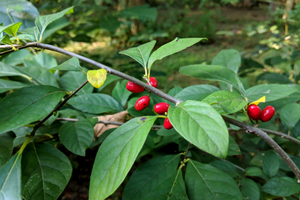 Look for this shrub in the early spring in rich woodlands and along streams.
Look for this shrub in the early spring in rich woodlands and along streams.
It may grow up to fifteen feet tall with multiple spreading branches.
The key is the smell. The smooth branches give off a spicy odor when you scratch them with your fingernail.
Leaves are light green, smooth and small and pointed. Parts used include the bark, twigs and the berries.
Related: If You See This Berry, You May Want To Harvest It
Collect a handful of short twigs. Cut and tie them together and drop them into any stew to add a flavor similar to allspice. Dry and grind the berries into a powder to add to your spice breads or pumpkin pie just like allspice.
Garlic Mustard (Alliaria Petiolata)
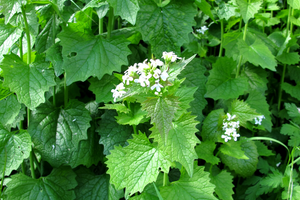 Garlic Mustard is very easy to find and is one of the first herbs of spring.
Garlic Mustard is very easy to find and is one of the first herbs of spring.
It grows prolifically in lowland woody areas in either shade or part sun.
The long sturdy stems rise upwards with triangular to heart-shaped, serrated, edible leaves that are soft to touch.
The greens grow for three weeks before tiny clusters of white flowers emerge from the juncture of the stem and leaf. Parts used include the aerial parts, leaves, stems (the young and tender ones), and flowers.
This herb is an excellent source of Vitamin C. It contains 190 mg of Vitamin C per 100 grams. Like Chickweed, you can spice up a salad or sandwich with them.
This herb should not be used by those with thyroid conditions because it makes iodine levels slightly fluctuate. For most, however, it is perfectly healthy.
How To Make Garlic Mustard Pesto
- Combine a cup of chopped garlic mustard leaves with one tablespoon of chopped onion, ¼ cup of parmesan cheese, and ¼ cup olive oil.
- Blend well in your mixer. Add a little water if required.
- Use as a sandwich spread or with any pasta or grain.
Wild Garlic (Allium Sativum)
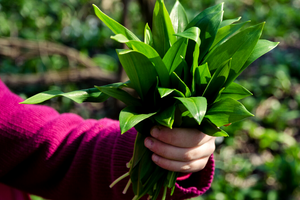 Wild garlic and onion generally grow in the eastern half of the U.S..
Wild garlic and onion generally grow in the eastern half of the U.S..
Long narrow pencil-like stalk bulbs grow in clusters beneath the dirt attached to the stalks.
You can consume wild garlic in the same ways you would consume a regular bulb of garlic.
Wild garlic is delicious roasted. Cover it with olive oil and roast on a cookie sheet at 350 degrees for 10 minutes. Sprinkle it with salt and pepper and close the oven door. Leave the garlic in the over until the heat dissipates, then serve.
Oyster Mushrooms (Pleurotus Ostreatus)
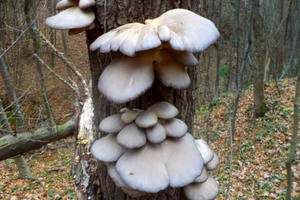 Following an early spring rainstorm, as the temperature rises, search for decaying aspen trees.
Following an early spring rainstorm, as the temperature rises, search for decaying aspen trees.
The Oyster mushroom grows in a light to golden yellow, white or golden bunch on a dead beech or aspen tree.
It fans out layer by layer feeding off of the aspen tree.
The gills are whitish to yellowish and mature caps grow up to fifteen inches. In the spring they will be much smaller.
You must know exactly which mushroom you are harvesting. Check with a couple of trusted sources before consuming. Also, wild mushrooms should be cooked for twenty-five minutes before eating.
The next time the sun comes out, prepare for an adventure outdoors and a forager’s feast with these recipes! I can guarantee that you won’t regret it.
You may also like:
 Some Firearm Tips for New Preppers and/or Those Who are New to Firearms
Some Firearm Tips for New Preppers and/or Those Who are New to Firearms
How To Make Wild Bread (With Dandelions) (Video)
Copyright © 2022 Ask a Prepper

Kathy is an herbalist/naturopathic practitioner who is constantly researching to expand her knowledge. She came to herbalism after her migraine medicine was suddenly removed from the market and she had to find something new. After discovering the magic of herbs she’s never looked back. She is accredited by the International Practitioners of Holistic Medicine (IPHM) and is an Associate Member of the American Herbalist Guild.